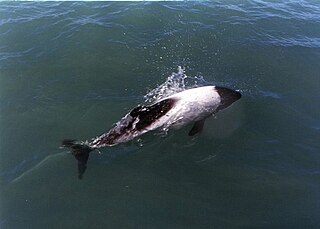
The International Union for Conservation of Nature (IUCN) Red List of Threatened Species, also known as the IUCN Red List or Red Data Book, founded in 1964, is the world's most comprehensive inventory of the global conservation status of biological species. It uses a set of precise criteria to evaluate the extinction risk of thousands of species and subspecies. These criteria are relevant to all species and all regions of the world. With its strong scientific base, the IUCN Red List is recognized as the most authoritative guide to the status of biological diversity. A series of Regional Red Lists are produced by countries or organizations, which assess the risk of extinction to species within a political management unit.

Commerson's dolphin, also referred to by the common names jacobita, skunk dolphin, piebald dolphin, panda dolphin, or tonina overa, is a small oceanic dolphin of the genus Cephalorhynchus. Commerson's dolphin has two geographically-isolated but locally-common subspecies. The principal subspecies, C.c.commersonii, has sharply-delineated black-and-white patterning and is found around the tip of South America. The secondary subspecies, C.c.kerguelenensis, is larger than C.c.commersonii, has a less-sharply delineated dark and light grey patterning with a white ventral band, and is found around the Kerguelen Islands in the Indian Ocean.

The mullets or grey mullets are a family (Mugilidae) of ray-finned fish found worldwide in coastal temperate and tropical waters, and some species in fresh water. Mullets have served as an important source of food in Mediterranean Europe since Roman times. The family includes about 78 species in 20 genera.

A least-concern species is a species that has been categorized by the International Union for Conservation of Nature (IUCN) as evaluated as not being a focus of species conservation because the specific species is still plentiful in the wild. They do not qualify as threatened, near threatened, or conservation dependent.

An IUCN Red List Critically Endangered species is one that has been categorized by the International Union for Conservation of Nature as facing an extremely high risk of extinction in the wild. As of 2021, of the 120,372 species currently tracked by the IUCN, there are 8,404 species that are considered to be Critically Endangered.

Pterois miles, the devil firefish or common lionfish, is a species of ray-finned fish native to the western Indo-Pacific region. It is frequently confused with its close relative, the red lionfish. The scientific name is from Greek pteron, meaning "wing", and Latin miles, meaning "soldier".

Cylindrocline is a genus of flowering plant in the family Asteraceae.

Pterois antennata, the spotfin lionfish, banded lionfish, broadbarred lionfish, broadbarred firefish, raggedfinned firefish, raggedfinned scorpionfish or roughscaled lionfish, is a species of marine ray-finned fish belonging to the family Scorpaenidae, the scorpionfishes and lionfishes. It is found in the tropical Indian and Western Pacific Oceans.

The bluespotted cornetfish, also known as smooth cornetfish or smooth flutemouth, is a marine fish which belongs to the family Fistulariidae. This very long and slender reef-dweller belongs to the same order as the pipefishes and seahorses, called Syngnathiformes.

The World's 25 Most Endangered Primates is a list of highly endangered primate species selected and published by the International Union for Conservation of Nature (IUCN) Species Survival Commission (SSC) Primate Specialist Group (PSG), the International Primatological Society (IPS), Global Wildlife Conservation (GWC), and Bristol Zoological Society (BZS). The IUCN/SSC PSG worked with Conservation International (CI) to start the list in 2000, but in 2002, during the 19th Congress of the International Primatological Society, primatologists reviewed and debated the list, resulting in the 2002–2004 revision and the endorsement of the IPS. The publication was a joint project between the three conservation organizations until the 2012–2014 list when BZS was added as a publisher. The 2018–2020 list was the first time Conservation International was not among the publishers, replaced instead by GWC. The list has been revised every two years following the biannual Congress of the IPS. Starting with the 2004–2006 report, the title changed to "Primates in Peril: The World's 25 Most Endangered Primates". That same year, the list began to provide information about each species, including their conservation status and the threats they face in the wild. The species text is written in collaboration with experts from the field, with 60 people contributing to the 2006–2008 report and 85 people contributing to the 2008–2010 report. The 2004–2006 and 2006–2008 reports were published in the IUCN/SSC PSG journal Primate Conservation,, since then they have been published as independent publications.

Pomadasys commersonnii, the smallspotted grunter, is a species of ray-finned fish, a grunt belonging to the family Haemulidae. It is native to the brackish and marine waters of the western Indian Ocean.

The white sucker is a species of freshwater cypriniform fish inhabiting the upper Midwest and Northeast in North America, but it is also found as far south as Georgia and as far west as New Mexico. The fish is commonly known as a "sucker" due to its fleshy, papillose lips that suck up organic matter and aufwuchs from the bottom of rivers and streams.

Commerson's anchovy, also known as Devis's anchovy, long-jawed anchovy, Teri anchovy, is a species of anadromous ray-finned fish in the family Engraulidae. It is known as haalmassa in Sri Lanka, where it is widely used as a nutrient-rich fish meat. It is widely used as a live or dead bait in tuna fishery.

Solanum commersonii is a species of wild potato in the family Solanaceae. It is native to southern Brazil, Uruguay, and northeastern Argentina, and has been introduced to Mauritius. It is being extensively studied for its resistance to root knot nematode, soft rot, blackleg, bacterial wilt, verticillium wilt, Potato virus X, tobacco etch virus, common scab, and late blight, and for its frost tolerance and ability to cold acclimate, in an effort to improve the domestic potato Solanum tuberosum.















